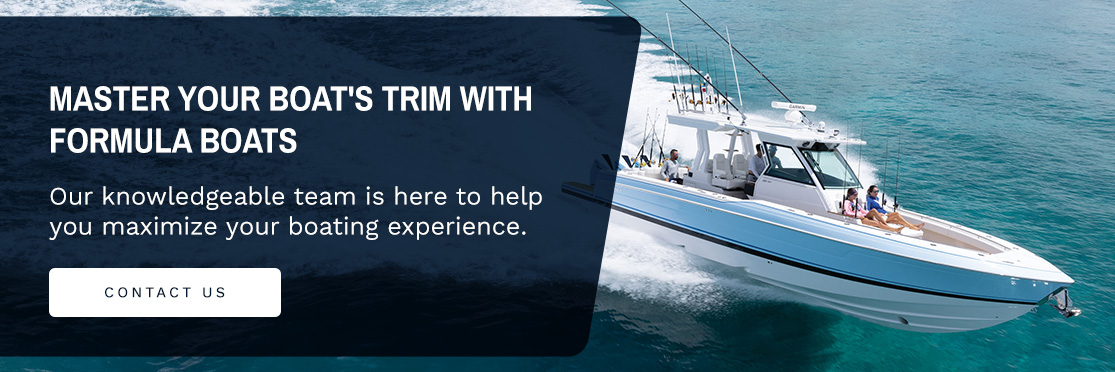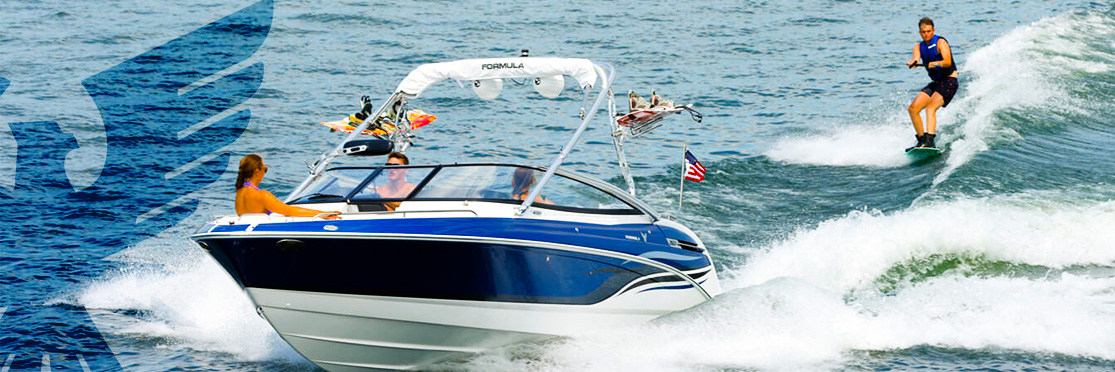
Mastering your boat’s trim is essential for optimal speed, fuel efficiency and comfort on the water. This guide will help you understand what trim on a boat is and how to use it to your advantage, whether you’re a seasoned boater or just getting started.
What Is Trim on a Boat?
Trim on a boat refers to the angle at which the bow and stern of the boat sit in the water relative to the waterline. This angle directly impacts your vessel’s performance, including speed, fuel efficiency and ride comfort. Boats handle best when running parallel to their at-rest waterline, meaning the trim is adjusted so the boat is level fore and aft.
There are two primary ways to adjust a boat’s trim:
- Power trim: On outboard and sterndrive boats, a power trim adjusts the engine angle or drive unit in relation to the transom, which is the flat surface at the back of the boat. By tilting the engine or drive up or down, the power trim changes the angle of the propeller’s thrust, which affects the boat’s trim.
- Trim tabs: These are independently adjustable plates mounted on either side of the transom. They work with a power trim to optimize performance. Trim tabs deflect the water flow, creating upward pressure on the transom and fine-tuning the boat’s trim.
Power Trim
To give boaters the ability to adjust and maintain the proper angle, outboard and sterndrives feature a power trim adjustment that gives you the ability to tilt the drives’ angle out or in. However, this means the propeller handles the power trim, which was designed to force the boat in a forward motion. When the prop is used for trim, the prop is pushing the boat forward in addition to raising and lowering the stern — this increases the prop slip, killing your boat’s performance. The power trim adjustment is also ineffective at slower speeds and is unable to correct listing.
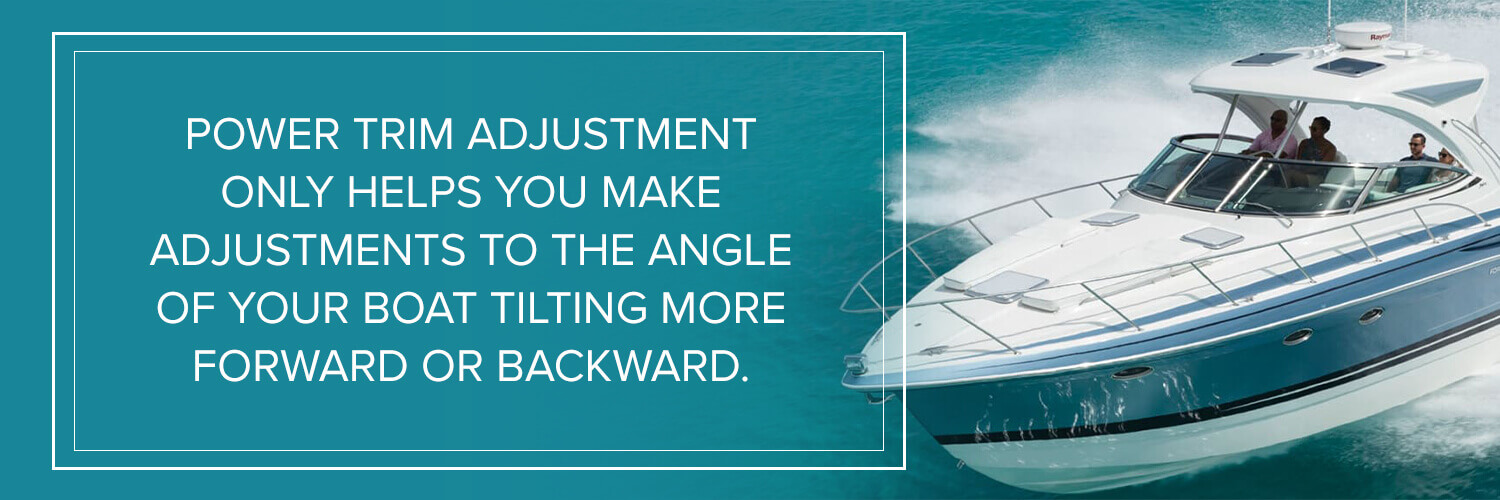
In addition to increasing prop slip, the power trim adjustment is solely for adjustments on the axis that runs closer to the bow — or front of the boat — and aft — closer to the stern, or back of the boat. In other words, power trim adjustment only helps you make adjustments to the angle of your boat tilting more forward or backward. What happens when you need to correct a leaning problem, known as a list? The simplest answer is to redistribute the weight of passengers and cargo to compensate for the sideways list, but conditions are always changing, and redistributing weight at higher speeds can have a magnified effect on the shift of the boat.
To maximize the control of your trim and address both of these issues — avoiding prop slip and making lateral adjustments — adding trim tabs to the transom is ideal.
Trim Tabs
Trim tabs are two independently adjustable metal plates controlled by a panel at the helm. These tabs can help compensate for engine torque or unequal weight distribution. What do trim tabs do on a boat? They give you the ability to trim the hull and the prop independently and to make lateral adjustments to avoid sideways list. Since the trim tabs can take over trimming the hull, the power trim can focus solely on adjusting the prop. By having the power trim and trim tabs work together, your boat achieves optimum performance and efficiency you can’t get with the power trim alone.
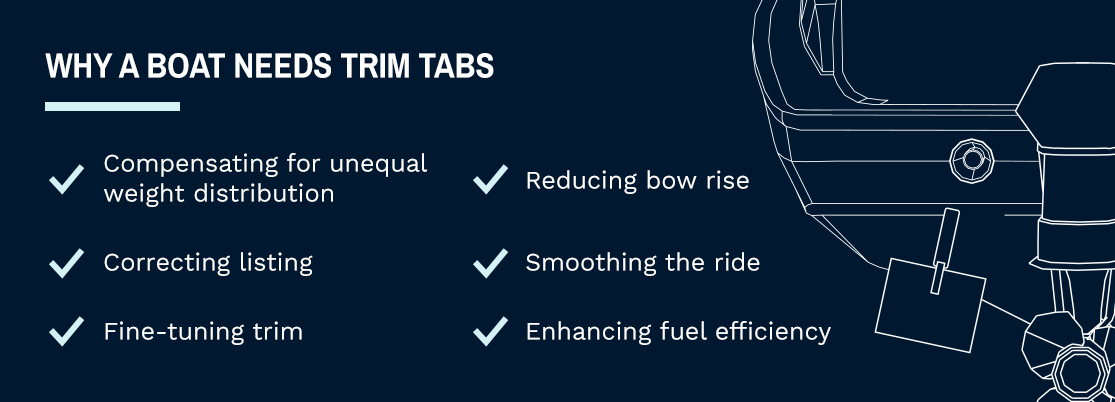
Now you understand what trim tabs do on a boat — but how do they do it? These tabs are mounted on either side of the transom of the boat. They are completely independent and unconnected to each other. When you’re focused on adjusting the power trim of the boat, you now have two additional metal plates you can use to do the heavy lifting when it comes to tilting the engine in or out. In this case, you’d have both metal plates tilted about the same angle in or out, to match the power trim of the engine. This alleviates some of the work on the prop and helps you maximize performance.
But what happens when you start to notice the boat leaning? Without trim tabs, there isn’t much you can do besides moving passengers and cargo or adjusting your speed and route. Fortunately, you can adjust each of the trim tabs independently and can easily compensate for a shift in sea conditions, weather, etc., without having to make adjustments in weight distribution or changing your route.
Now you know what trim tabs do on a boat and how they do it, you may be wondering what trim tabs you need. There is no one-size-fits-all solution for trim tabs. The size of the tab you need depends on several factors, including the engine, weight of the boat, length of the boat, weight distribution and type of boat, among other things.
Boat Trim Terminology
If you’re new to trimming the boat engine, it’s helpful to learn the terminology so you can use your boat’s trim to your advantage. This boat trimming lingo includes:
- Trimming up: Tilting the engine forward to move the propellor up, tilting the bow upward.
- Trimming down: Tilting the engine backward to be even with the transom, a position. Shifting to this position, also known as “zero trim,” brings the propeller closer to the boat and tilts the bow downward.
- Porpoising: The bow of the boat moves up and down due to over-trimming at a cruising speed.
- Positive trim: The boat trim is fully up and out of the water. This position allows too much air under the hull.
- Negative trim: The boat trim is fully down. As the bow dips toward the water, the boat is in danger of taking nosedives.
- Neutral trim: The engine is parallel to the boat’s transom. Also known as “zero trim,” this position puts the propellor even to the water.
Tips for Using Your Boat’s Trim
Whether you’re just getting started with learning power trim adjustments, or wondering how to use trim tabs in rough water, we’ve gathered some valuable tips for using your boat’s trim. We’re sure these will come in handy as you begin searching for your boat’s perfect trim — regardless of whether you’re boating in a lake or on the ocean. It’s important to remember each boat’s trim is different, so for every boat, factors such as the balance of trim, weight of the boat, sea conditions, speed, etc., are a little different. While these are general tips, it’s important to always operate your boat with caution as you begin discovering your boat’s ideal trim:
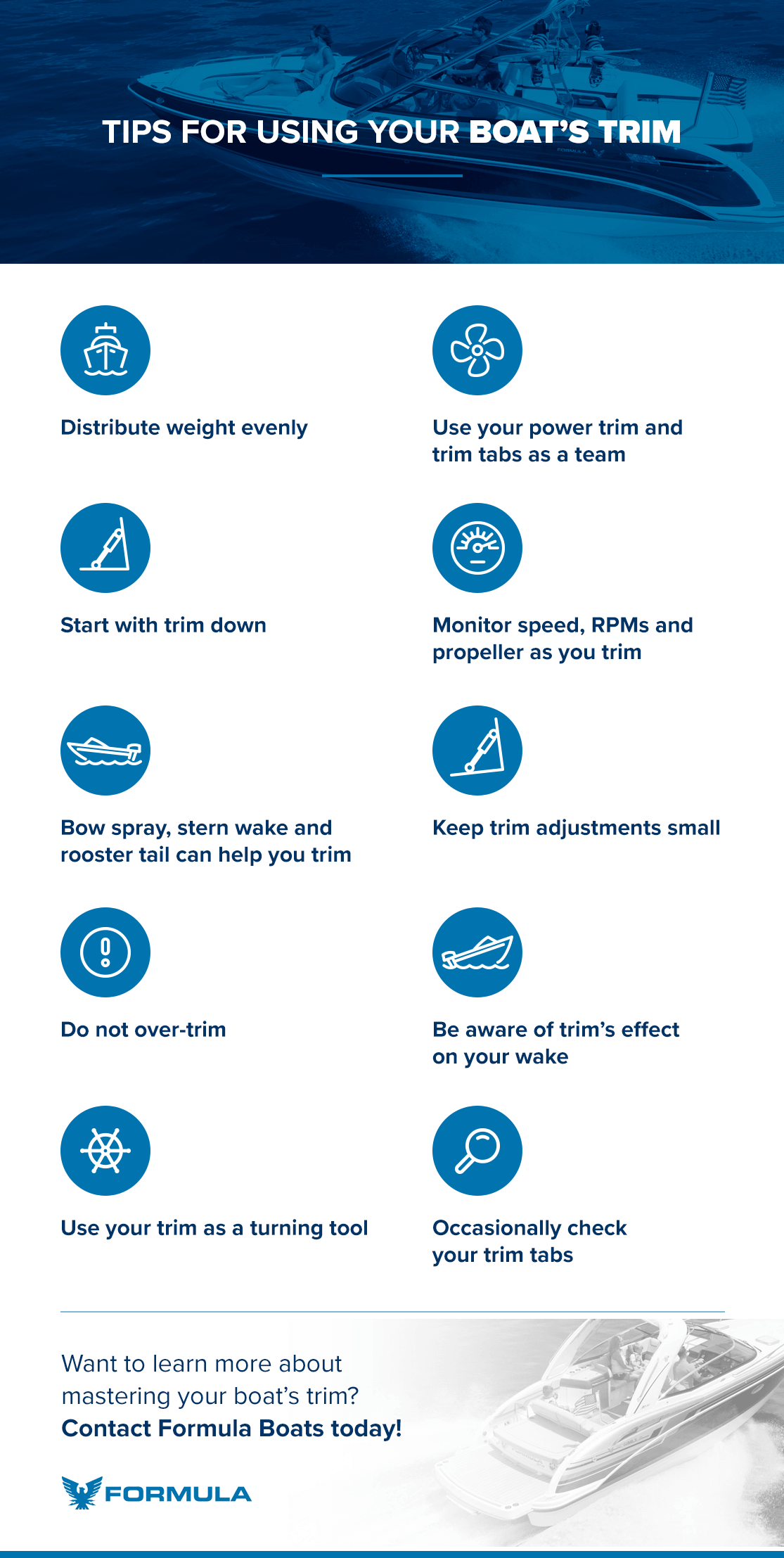
- Distribute weight evenly: Before you leave the dock, check to make sure the weight of the boat is distributed evenly, so it sits evenly in the water. Even though you can use power trim and trim tabs to compensate for uneven weight, it’s ideal to begin with distributing weight as evenly as possible.
- Use your power trim and trim tabs as a team: We’ve shared why a boat needs trim tabs — it’s so important, it’s also on our list of tips. Remember to use the power trim to adjust the prop path parallel to the water flow. Use trim tabs to trim the hull of the boat — both up and down and from side to side. When you use the two of them together, each controlling their part of the trimming process, you maximize your boat’s performance.
- Start with trim down: When you’re taking off from displacement speeds, most boats work best with the engine and bow trimmed down — this helps the boat rise quickly onto the plane. However, once your boat is on plane, it’s important to adjust the trim based on the sea conditions.
- Monitor speed, RPMs and propeller as you trim: As you begin to trim up, pay attention to your speed, RPMs and propeller ventilation, as these three are key to knowing when your boat is properly trimmed and running at maximum efficiency. Trimming up will eventually trigger a slight drop in speed, a sharp rise in RPMs and/or propeller ventilation — at this point, you’ve trimmed up too far. Begin trimming down in small increments to reach your maximum speed, consistent RPMs or lack of propeller ventilation, and you’ll strike a balance for proper trim.
- Bow spray, stern wake and rooster tail can help you trim: If you’re steering your boat from a bridge or tower, you have the opportunity to observe some additional characteristics related to spray and wake that can help you find your boat’s ideal trim. If you see more spray toward the stern of the boat and a larger wake, the boat’s trim can be better — unless, of course, you’ve got a boat full of waterskiers and wakeboarders. When your boat is reaching its proper trim, you’ll notice the bow spray is farther forward, the wake is smaller and the rooster tail is also smaller and farther behind your boat.
- Keep trim adjustments small: To find that sweet spot for your boat’s trim, it’s important to make sure you adjust your trim tabs using short, half-second bursts — followed by a pause to let the boat react — before moving on to make another adjustment. How long it takes each boat to respond is different, as the size of your trim tabs and your boat’s speed affect the timing. Be patient.
- Do not over-trim: Make sure you do not over-trim — that is, deflect the trim tabs too far — especially at high speeds. Extreme changes to the angle of the bow on the move, combined with sea conditions, can cause the boat to veer. If you have trim tabs, remember that even though the trim tabs are independently adjustable, you should not move one trim tab significantly further down than the other one, as it may cause the boat to lean suddenly to one side.
- Be aware of trim’s effect on your wake: Trim settings will change the size of your wake. You want to trim down to minimize your wake in a slow or no-wake zone. On the other hand, if you’re looking for a better wake for waterskiing or wakeboarding, trim up while adding speed, and you might see a rooster tail.
- Use your trim as a turning tool: When you enter a turn, begin trimming down — at this point, the more down trim, the more you can accelerate through a turn. When you’re in the sharpest part of the turn, you should have the maximum amount of down trim, based on the turn speed and the turn radius. As the boat slows, add throttle. As you begin straightening the wheel to come out of the turn, begin to trim up.
- Occasionally check your trim tabs: As with any part of a boat, trim tabs can have loose or corroded wires over time. Since they can have such an impact on the trim of your boat, it’s important to inspect them visually to ensure they aren’t in need of repair. Malfunction or failure of trim tabs can be dangerous.
Adjusting Trim for Optimal Performance in Various Sea Conditions
If you’ve been wondering how to use trim tabs in rough water, you’re not alone — in fact, regardless of whether you have trim tabs, you must consider sea conditions, since they directly impact how you find your boat’s perfect attitude. Therefore, your boat’s attitude should change depending on what type of sea you encounter. Be mindful, small adjustments can have a big impact — in both power trim and trim tab adjustments, but also adjustments in weight shifting on the boat. Just because you’ve changed your boat’s attitude to match sea conditions doesn’t mean you can set it and forget it on the water. Passengers moving on the boat and changing sea conditions are two reasons finding your boat’s perfect attitude can be a permanent work in progress.
Here are some adjustments you should consider making to improve your boat’s attitude in each of the following sea conditions.
- Choppy head sea — If you find yourself running into a head sea, you should trim your boat down so the sharp forward sections of the boat are cutting into the waves. Bringing the “V” of the hull in contact with the waves will help alleviate the waves pounding the hull, and any passengers you have on the boat.
- Following sea — Your trim tabs should be fully retracted in a following sea or when running an inlet. Keeping the tabs up will ensure the current won’t push the stern from side to side — ultimately giving you maximum steering control and the best maneuverability
- Beam sea — When waves are approaching from the side of the boat, passengers often notice a spray of water from the windward side. By adjusting the trim tabs to raise the windward side of the boat, you can block the spray the wind brings over the boat, keeping your passengers dry.
- Correcting porpoising — If you have a performance boat, chances are you’re familiar with the condition known as porpoising — as you increase speed, the bow of the boat rises out of the water and then bounces back down when gravity overcomes it. To help alleviate this, press “bow down” in half-second bursts and the trim tabs will deflect. As they deflect, the porpoising will subside — the only effect you’ll see on your speed is a potential increase. It shouldn’t take much, so make sure you don’t overdo it.
- Backing down — When you’re operating the boat in reverse, make sure you have both trim tabs fully raised. If you leave them down, they produce drag, which puts a strain on the tabs, but also has a negative effect on the boat’s handling — and that’s just if you leave them both down at the same level. If one tab is deflected more than the other, the boat will likely pivot in that direction. The easiest way to avoid any trouble with trim tabs in reverse is just to make sure they are fully retracted — in that case, they’ll have no impact on backing down.
Master Your Boat’s Trim With Formula Boats
Understanding your boat’s trim takes the right set of tools, knowledge and patience. At Formula Boats, we’ve been a boat manufacturer and dealer for more than 60 years, giving us expert knowledge in optimizing boat, engine and trim tab performance for increased speed, smoother rides and improved fuel efficiency.
Contact us today if you have questions about perfecting your boat’s trim or need guidance on where to start. Our knowledgeable team is here to help you maximize your boating experience.

